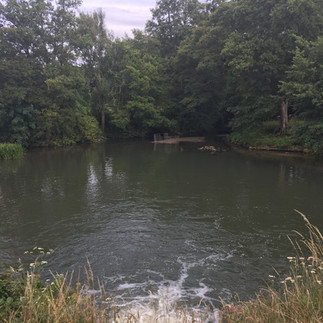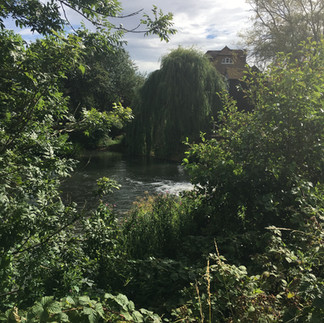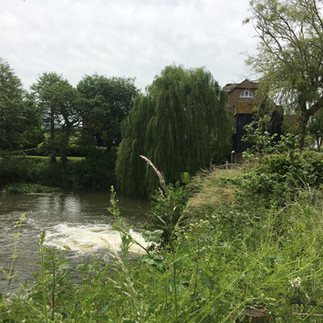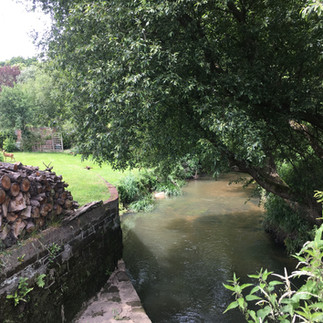
The sun blazed while the thunder yet
Added a boom:
A wagtail flickered bright over
The mill-pond's gloom:
Less than the cooing in the alder
Isles of the pool
Sounded the thunder through that plunge
Of waters cool.
Scared starlings on the aspen tip
Past the black mill
Outchattered the stream and the next roar
Far on the hill.
As my feet dangling teased the foam
That slid below
A girl came out. "Take care!" she said -
Ages ago.
She startled me, standing quite close
Dressed all in white:
Ages ago I was angry till
She passed from sight.
Then the storm burst, and as I crouched
To shelter, how
Beautiful and kind, too, she seemed,
As she does now!
On 15th June 1914, Edward Thomas recorded a visit, possibly walking but more likely cycling with an unknown companion, probably his son Mervyn, to the "Mill nr Trotton" in the Rother valley seven miles east of his home in Steep. In his Field Note Book (72) he wrote of "the hollow mill pond w(ith) steep sandy edges & islets of alders". There were chaffinches and yellow wagtails which flew out over the pond for insects. One of the two floodgates poured down "rumbling foam that does not drown the dove's croon in big aspen by Mill House or the starlings' anxious chatter or the thunder overhead..." Here are many elements of the poem he wrote some six months later, albeit with some changes in emphasis. In the FNB he includes more description, "the bramble...overhanging stone walls of floodgates"; ''the wrinkled water w(ith) shallows amber at edge" and the "black timbered mill".
The storm seems to have broken later than described in the poem when they were on their way back to Steep at 4pm. But the thunder was a constant presence - between 1pm and 3pm as they went up to the Downs by Treyford, "the thunder darkening the hills w(ith) misty gloom keeps chivying us". In the Downs above Treyford it was "blazing hot between the early spatterings as we sat am(on)g clematis black bryony blackthorn hazel & ash".

In June 1914 Edward Thomas had not yet written a poem but he was beginning seriously to consider doing so, influenced by the American poet Robert Frost. Frost and his family were over in England for a prolonged stay and Thomas had already stayed with Frost twice, and was to spend many more weeks with him during 1914 in the Leadon Valley on the Herefordshire/Gloucestershire border. The Frosts were in England partly because of the more positive reception Frost's own poems received here from critics, in particular from Edward Thomas who had developed into the country's foremost poetry critic. Frost's second book of verse North of Boston, just published, had arrived a week before ET visited the mill-pond and he had eagerly devoured it on a train journey up to London in preparation for a series of very positive reviews. ("There is not a bad one among them, not one I haven't enjoyed very much" he wrote to Frost).
Is it coincidence that Thomas wrote in such detail a week later about the visit to the mill-pond? Was it already in his mind to search for subjects of poetry in the notes he jotted down of these everyday activities and encounters - as Frost encouraged? In North of Boston Frost had also written about everyday matters such as mending walls, apple picking, a walk up a mountain, the wood pile, visiting the black cottage. Although ET had written up many such expeditions in his field note books previously, only a few have the coherence and level of detail about a particular place that this entry about the mill-pond had. (Mills and their mill ponds were always places of interest to ET - later in 1915 he was to write about the mill race at Steep, all that remained of the local mill there.) A few months later at the beginning of 1915 he clearly identified the entry for development into a poem when including "15th June Trotton mill" in a list of ideas for possible poems in FNB 80. And on 18th January 1915 he wrote the poem, The Mill-Pond.

What was lacking in the FNB entry was any mention of the girl. His memory of her may have been from much further back than the visit to Trotton mill - possibly over ten years earlier. He wrote about in one of his first country books - The Heart of England published in 1906. In the chapter Apple Blossom he described another mill-pond: "The stream going helpless and fast between high banks is gloomy until it is turned to bright, airy foam and hanging crystal by the mill; over the restless pool below hangs a hawthorn all white and fragrant and murmurous with bloom." Later the farmer's daughter appears "in a white dress, on her head a mushroom-shaped straw hat that reveals black hair curving like the wings of a dove over the half-moon of her brow, and like smoke above her golden nape.....She walks like a summer cloud...."
So the girl in the white dress who says "Take care!" and startled and angered ET "ages ago" may well have been this more ancient memory of the farmer's daughter, now appearing like a ghost within the memory from the previous summer of a different gloomier mill pond.

The mill at Trotton is actually called Terwick mill on the river Rother and, to add to the confusion, is closest to the village of Dumpford. The pond is still quite gloomy surrounded by trees - alders, ash, willows and oak. A footpath runs by the black timbered mill and past the two floodgates through one of which the foam plunges down beneath. It's easy to imagine ET and his son sitting dangling their legs above the foam. Since ET's day, houses have been built all the way up the lane, where previously there had been just the farm, the mill and an oak, at the beginning of the lane, still there.
ET might have visited the mill on more than one occasion - he seems to have gone there in the early summer of 1908 and in the winter 1909/10. It might have appealed to him in busy times as a place where he could spend a few hours away from his study and the hangers. In May and June 1914 he had been very busy both with reviews and also with the manuscript of his latest book A Literary Pilgrim in England. That month he also spent a couple of days in London before visiting the mill pond. Later in the month he was to undertake an excursion up to Silverdale close to the Lake District to see his friend Gordon Bottomley before returning to London (to see the first night of Richard Strauss's Joseph which he did not enjoy); before setting out again with Helen to stay with Robert Frost and family in the Leadon valley (en route his train stopped at Adlestrop which provided more poetic inspiration); then returning via Coventry to visit the Hodsons, their old friends from Bedales. It was a hectic schedule, so spending an afternoon pottering through the country before embarking would have been a pleasant break in preparation. And the weather which had become increasingly muggy in June would have made the River Rother an attractive destination.
His observations of the elements and the natural world in this entry as always seemed to have combined to ground him and take him out of himself. The relationships between the sound of thunder "far on the hill" and the dove's cooing in the alder and the starlings chatter was extended in his field note book entry to his observations of other birds on a stormy day. "Loud thunder over as at 3 but thrushes sing & rain starts & ceases & starts & ceases. Rooks there? soar up caw above the hills as early thunder on downs". Later he notes "Willow wren sings in worst thunder & rain."

Following the visit to Terwick Mill they made their way to Treyford under the Downs, stopping off at the ruined church of St Mary's by the manor house, where he noted "ivy & elder among the beams & the frescos reddened. Triple E(arly) E(nglish) windows." They then climbed up the Downs "by deep cut single chalk r(oa)d" to the remote Buriton farm and the hamlet of Hooksway, with "wild rose & thorn & ash" on the way up. It looks like they then returned via Rogate to Steep, ET noting "low hedges of hazel....overtopped by bracken & mixed w(ith) white burnet rose & honeysuckle - delicious"!
He also noted the ever-changing sky - something he did regularly in his notebooks, especially when looking out from his study at the top of Ashford Hangers. Overhead at the mill-pond there were "loose-edged dark manes...seething fr(om) several directions with some pale gaps". Later at 4pm he saw "above the soft dark downs...a mimic loftier & similar range, depressing and dwarfing it (the downs), but with rougher ridge agst the ruddy lightening clouds". Back at Steep at 4.30 "a sky of soft grey clouds but w(ith) a world of marble m(oun)t(ain)s & blue behind & some showing white. One small range on the E(ast) is rosied." At 6.15 "the sky had the white m(oun)t(ain)s very dim in S&E & some fine white overhead, but also layers & screens of soft dark grey & soon after loose lower drift, but no rain."
It was the end of an eventful day when ET took an important step towards his poetic destiny.

A walk
There are a number of walks that can be done to follow in ET's footsteps that day: a walk from Petersfield along the Rother; the walk along lanes or footpaths from the mill towards the Downs past Elsted to Treyford, visiting the ruins of its original church (and the nearby graveyard of all that remains of its successor, St Peter's, known as "the cathedral of the downs"). Or from Treyford you can walk up the Downs (or park at the top) along the lovely high valley of Buriton Farm beneath Pen Hill, crossing the South Downs way and on to Hooksway with its fifteenth century inn, the Royal Oak.
I have chosen instead a short walk from the mill to Trotton bridge, following the Rother to Chithurst and then returning over fields to the mill. The river by late June is often surrounded by trees and bushes in full leaf, making these stretches gloomy even on a bright day. It's also slow moving and can be choked with branches and other debris.
The walk visits the three parishes of Treyford, Trotton and Chithurst, past the latter two parish churches and the heart of these ancient communities.
Parking at Dumpford you walk up Mill Lane towards the mill. The mill is no longer a working mill - it closed in 1966 and has been converted into a private dwelling but the structure including the black-boarding remains. The river and pond seem to have changed somewhat - taking the river and race away from the dwellings and as a result the islet of alders is now joined up to the original river bank. The mill pond surrounds are also more manicured than they probably were in ET's day but the pond with its surrounding trees and bird life are still recognisable from the poem.
Crossing the field beyond the mill pond you go through a gate and pass by early 19th century Terwick Mill cottages, bearing right down a track to pass Trotton's Old Rectory. When you get to the busy A272 you can detour to see Trotton's parish church, St George's. Beyond it, is Trotton Place which dates from c1600 but was refaced in the 18th century.
From the church you go left along the A272 crossing over the ancient Trotton bridge and a few yards beyond there is a footpath taking you through the meadows to Chithurst lane. There is a good view across the meadows and the Rother to the church and Trotton Place. You follow Chithurst lane down to the bridge over the Rother again and take the path on the left after the small church of St Mary's. From the graveyard you can see a glimpse of Chithurst Manor. You follow the footpath west along the long wall on your left that hides the manor, before the path turns right/north along the side of a field though the grounds of Chithurst House, now a Buddhist monastery. you keep straight on through the woods until you reach a byway and take the left hand fork along Brier Lane. Continuing along the track for about 1/2 a mile you reach Gatehouse Lane. Taking a left you can either follow the lane or the somewhat indeterminate parallel path in the field down towards the A272. If on the lane, you want at some point to get into the field before reaching the A272. Follow the field edge round past a small plantation of trees keeping them on your left. You turn right when you reach the A272 and then go left down what is now called Rother Lane (but was called in ET's day Dirty Lane) back past Terwick Mill cottages to the Mill-pond.
To the various sounds that ET heard on that summer's day, can now be added the noise of traffic on the A272. The Downs are also a constant presence on this walk, lying serenely in the distance. On a sunny early summer's day there's still the feeling of a timeless South Country landscape as the poem describes.

Maps/coordinates etc
Best map for the walk is OS Explorer OL33 Haslemere & Petersfield. If you walk from Treyford up to the Downs instead, the map os OS Explorer OL8 Chichester.
Terwick Mill OS Grid reference SU86323; post code GU31 5JT
St George's Trotton Post code GU31 5EN
St Mary's Chithurst OS Grid reference: SU842230
Ruins of St Mary's Treyford SU242018685
A good walk from Treyford into the downs on the route that ET took that day can be found here: http://www.westsussex.info/south-downs-way-buriton-farm.shtml
Sources of quotes/references
FNB 72 Field Note Books - copyright Henry W. and Albert A. Berg Collection, New York

























コメント